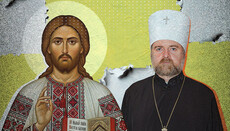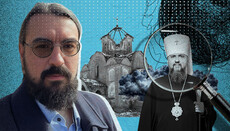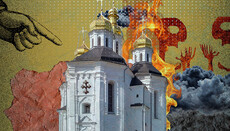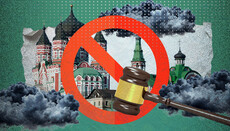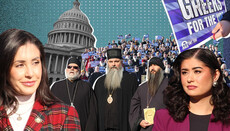Minsk "Maidan" and the autocephaly of "Belarusian Church"
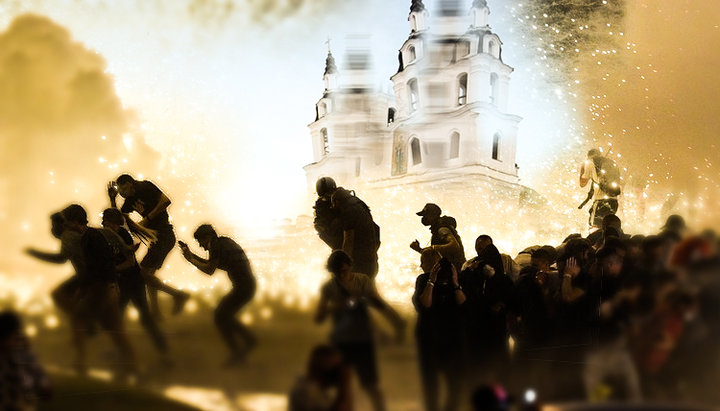
The religious theme is already being used at protests in Belarus. Is there a direct connection between the protests and the implementation of the church schism?
Mass protests in Belarus, which began on the day of the presidential elections on August 9, are increasingly similar to the "Maidan" scenario in Ukraine not only in terms of violent conflicts between rioters and law enforcers. Protests are also actively supported in the media space. The way it is done is often morally questionable.
Liberal media and social networks portray the participants in the Minsk riot as fighters for social justice. The rioters, throwing “Molotov cocktails” and cobblestones at law enforcers, are called noble “warriors of light” who are fighting against the “dark forces” of the totalitarian regime of Lukashenka. "Preachers of good" are opposed to "perpetrators of evil".
At the same time, the media do not hesitate to resort to outright lies and increase the atmosphere of hatred by reporting of those killed, injured, and detained.
For example, many media outlets reported that a human life is already on the conscience of law enforcers – a police car ran into an activist. At the same time, many journalists wrote that the police van did not just run over the man, but "drove into the crowd of protesters". Social networks began to circulate posts that "OMON is crushing people with special vehicles".
Fortunately, the man turned out to be alive, and later it turned out that he himself climbed onto the bumper of a police car and at some point fell onto the ground.
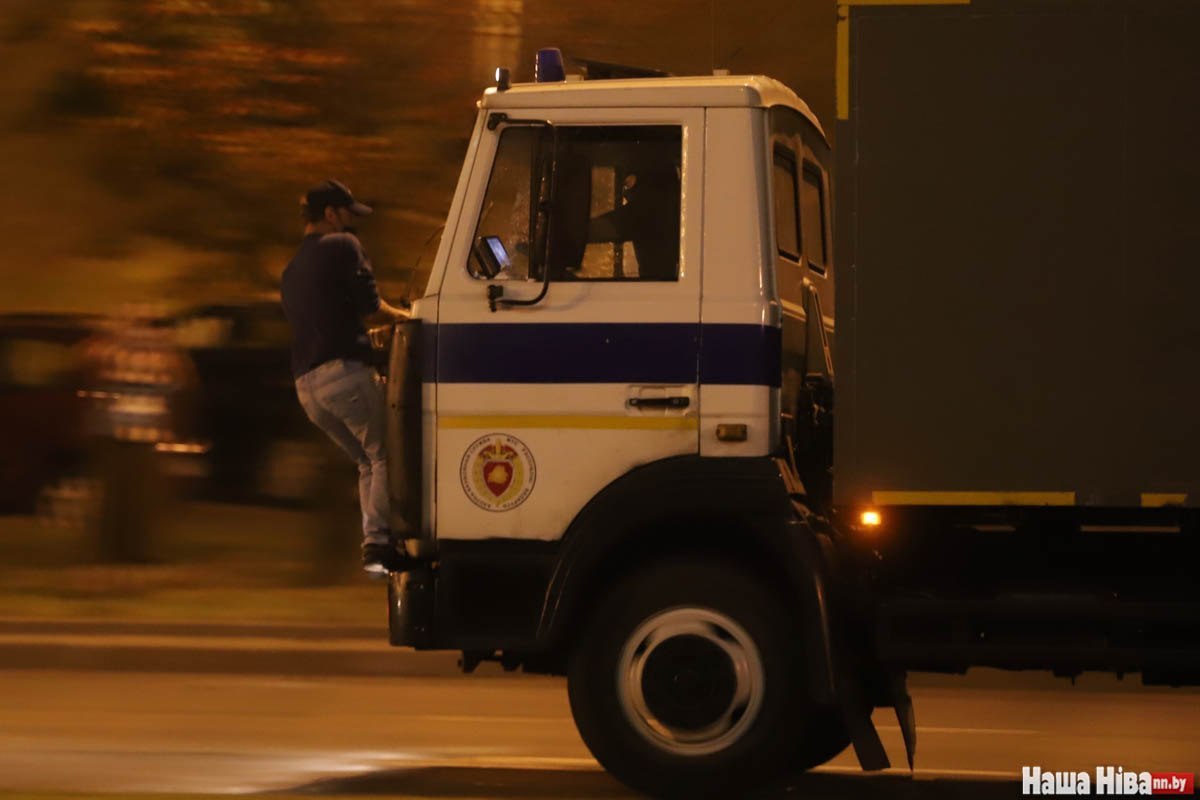
Another fake was intended to involve the "Russian trace" in the protest events. The Polish TV channel "Belsat" reported that "Russian special forces" were spotted in the dispersal of the protesters. Later, the report was deleted but it had already spread on the Internet and raised some other part of Belarusians to protests.
These examples show as clearly as possible the technologies that the media use to create the desired picture and form the "correct opinion" about what is happening in Belarus.
"Maidan theology" and sacralization of protests: Minsk in the footsteps of Kiev
The technology when one side of the conflict is idealized, and the other is dehumanized inevitably leads us into the sacral sphere. We remember how many religious markers were used on Euromaidan: “Ukrainian Golgotha”, “Heavenly Hundred”, etc. Therefore, there is no doubt that in order to attract the maximum number of people to the Belarusian protests, their organizers will sooner or later involve a religious theme.
It is known that not all citizens of a particular country are politically active and ready to fight for their political views. The majority of the population of any country stands for stability and is afraid of any radical change. For example, in an interview with a journalist of the Ukrainian edition “Strana”, one of the protesters in Minsk directly said that the mentality of Belarusians does not favour the participation in “maidans”, and the organizers have to do something with this: “Many of those who spent the night in the restaurant yesterday, looked at the rally disapprovingly. Not because they are for Lukashenko – they are for stability. And against the changes that Tsoi sings about. Belarusians love order most of all. And this is the problem for protests."
According to the “Maidan scenario”, to include as many people as possible in the protests, they should have not only political but also religious character.
So, as we can see, the participants of the Minsk riot understand that love for order is a problem for the protests. And one of the solutions to this "problem" is the sacralization of political protest. That is, to show that the "fighters for justice" have the highest, religious sanction, which in its turn will allow involving the maximum number of people in the riots. After all, if there are hundreds and thousands of politically active people, then there are millions of believers.
We know that Catholics, mostly Uniates, played a fundamental role in attracting people to Euromaidan in Ukraine. In Belarus, they also do not stand aside. Here is a photo from the protests where we see several Catholic clerics.
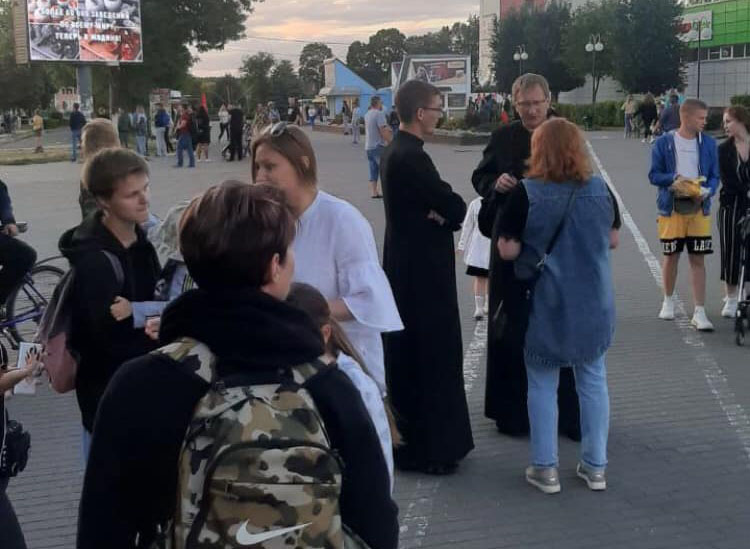
On August 12, Bishop of Vitebsk of the Roman Catholic Church in Belarus Oleg Butkevich made a very peculiar statement. He said that the counting of votes in the presidential elections was "not quite correct" and stressed that "the current crisis hides a positive potential for change for the better".
It is easy to notice that the words of the Catholic bishop contain a veiled call for believers to protest against the government.
But these are Catholics. And what about the Orthodox?
The head of the Belarusian Orthodox Church, Metropolitan Pavel emotionally called on his compatriots to stop the enmity: “Let's all stop together, let’s end this enmity and hatred. Because as long as passions rage in us, we cannot make any correct decision. Only with a cool head and fervent prayer can we find a solution to what worries us. Yes, there are some concerns, but they can be solved and must be solved not through confrontation, and God forbid that blood be shed again.”
In their content, these words are fully attuned to the calls of His Beatitude Onuphry, who repeatedly asked the confronting parties in Ukraine to find the strength to reconcile.
In Ukraine, the UOC is a stronghold of the peace process in society. But there were also several people who welcomed and encouraged riots at Euromaidan in 2013.
Georgy Kovalenko, one of the clerics who later found themselves in a schism, said on August 10 that thanks to the protests in Belarus, an analogue of the OCU, the Orthodox Church of Belarus, is, in fact, operating: “The Orthodox Church of Belarus is already a reality, albeit unconscious and unorganized.”
It is interesting that Kovalenko was among those who took the most direct part in the creation of the Ukrainian "Maidan theology". According to this "theology," Christ was invisibly present at the protests and everything that happened on the Maidan occurred by God's will. In addition, in his manifesto "Theology of Maidan" Kovalenko's associate, Archimandrite Kirill (Govorun), clearly outlined the goals and objectives of the "new church consciousness": “Maidan gave an impetus to the Churches to rise above the status quo that reigned in their relations with the state throughout the years of Ukraine's independence, and to take the side of society. Now the Churches should take a step further and give their frank assessment of this power."
That is, after the sacralization of the protests, the "church" must come to grips with political issues – "assess the power".
"The Churches should take a step further and give their frank assessment of this power."
Archimandrite Kirill (Govorun)
At the same time, these "Maidan theologians" declared wonderful "fraternal" slogans about "all good versus all bad", spoke about the unity of activists in Christ. Here are the words of the same Govorun about those “Сhurches” that were present at the protests in Kiev: "From general calls to non-violence, they went on to align themselves with the values of Maidan in deeds and words, realizing that its principles are related to the Christian ones – the Maidan that showed many examples of altruism, willingness to sacrifice, mutual assistance, etc."
Let's call these values of the Maidan. Here is a document, in which 2013-Euromaidan supporters appealed to fellow citizens who did not favour the protests against the government.

Безусловно, красивые слова. Вот только спустя семь лет можно заметить, что практически ничего из написанного не было воплощено
Definitely, beautiful words. It is only seven years later that one can notice that practically nothing written has been realized. The social and economic situation in Ukraine has become much worse.
And the problem is that you can implement these theses not through a riot but only through patient and hard work. Therefore, these demands are not even beautiful slogans but cynical political technology, the only purpose of which is to cause a sense of aggression and the need for revolt.
Let's recollect that Georgy Kovalenko also spoke on the Kiev Maidan "correct" words. For example, he, together with representatives of other confessions, developed the so-called "Maidan commandments". Here they are:
"Do not kill" in the political language can sound like this: Violence – no!
"Do not bear false witness" – Lies and manipulations – no!
"Don't steal" – Corruption – no!
During the round table in Moscow on January 26-29, 2014 Kovalenko stated that "these commandments actually gave us the opportunity to speak about the political situation in biblical language and at the same time to assess it". Yes, but the question is, where exactly did this assessment lead him personally? To the schism. And the problem is not that Kovalenko somehow misinterpreted the words of the Holy Scriptures, the problem is that the Church should not give "political assessment" of the events that are taking place. Spiritual assessment – yes, it should and must give, but political – no. Because it is not its field and its sphere.
However, it seems that now, with the appearance of “Maidan” in Minsk, the same layer of "Maidan theologians" appears in Belarus.
Minsk "theology of Maidan"
Georgy Kovalenko, "prophesying" about the "Belarusian OCU," shared a picture created by the deacon of the Belarusian Church, Dmitry Pavlyukevich.
And there is nothing wrong in it: the cleric declares the Orthodox are against falsification, humiliation and pressure on individuals.
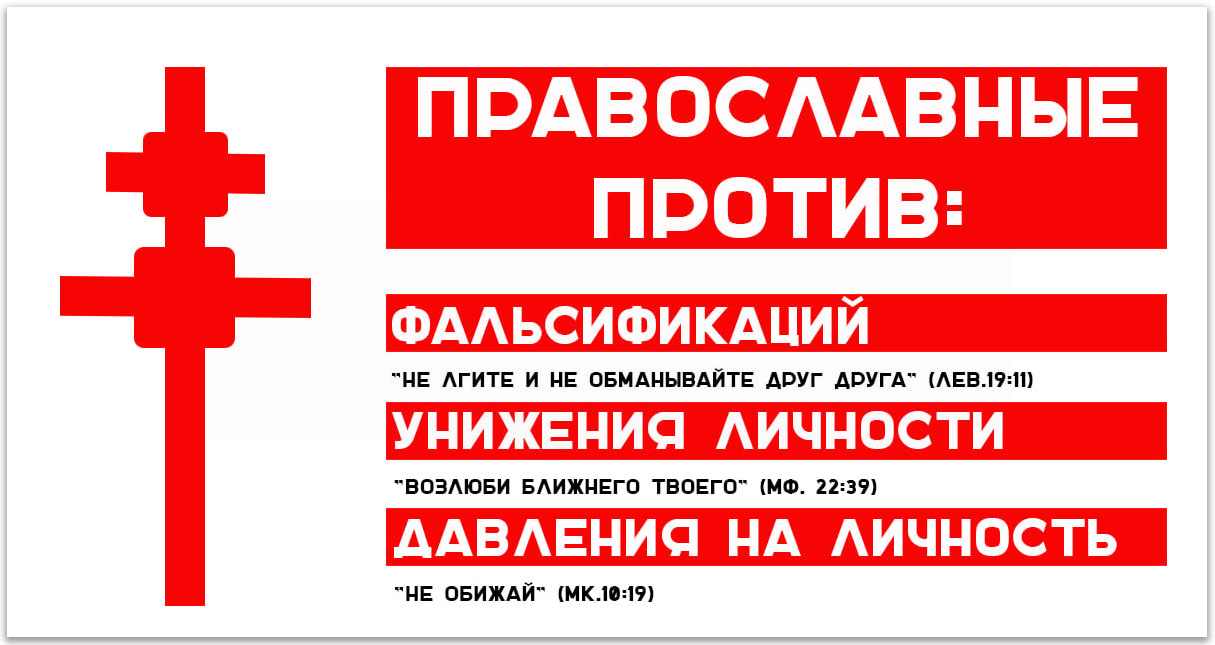
But in the protest environment, this picture has already spread as a kind of activists' manifesto. And what is very important – this manifesto contains church attributes (the cross, quotes from the Gospel), and therefore is perceived as the Church’s claim.
Father Dimitry said that he does not see any political motives in his actions: “I am a priest, I am a believer, and therefore I express my position. This is neither agitation nor a call, there is even grammatically no motivation for action. It is just an expression of my point of view as a believer. I am quoting the Gospel. It is surprising to me that this causes such a resonance in the Belarusian media. These are absolutely common places. Who can be surprised that the Church is against lies, that She is for justice? This is as clear as the fact that the Church is against abortions or same-sex marriages. Everyone knows this anyway."
At first glance, Father deacon's words are correct – the Church is really against corruption, falsifications, lies, etc. But with an elementary analysis, their manipulativeness becomes obvious. After all, making such publications in a situation when the society is divided and the country is on the verge of a violent confrontation is to drag the Church into confrontation and thereby add fuel to the fire of the conflict. There is one more manipulative moment – the cleric positions the Church on his own, “fair” side of the conflict. After all, Pavlyukevich does not hide the fact that his sympathies are with the rebels.
In addition, the words about “lies and falsifications” are used here by default as a marker of “Lukashenko’s regime”. But we already know that lies and falsifications are used to the full extent by the organizers of the protest. Therefore, the attempt to present the Church on the “fair” side of the conflict against the “unfair” one looks unjustified, unjust and anti-Christian.
And again, it is difficult to avoid the analogy with Euromaidan, where representatives of the UGCC, UOC-KP, RCC, and several members of the UOC "blessed" the Maidanites to protest against the authorities and assured them that they were noble "warriors of light" who were fighting against the Yanukovich’s "forces of evil".
The Church is really against corruption, falsification, and lies. But we think it does not do any good to say this at a time when people are agitated, when the country is shaken by protests and violent confrontation.
In the context of the unrest that began, this publication, like the statement of the Catholic Bishop Oleg Butkevich about "incorrect vote-counting", looks like a veiled call for protests. And here the most important point is the authors' affiliation with the Church. The “25th frame” signals the protesters – you are doing everything right, the Church and God are with you. But is it really so?
Maidan and the emergence of new "autocephalous Churches"
Catholics have their own interests. These interests, as we have seen recently in Ukraine, largely coincide with the interests of schismatics and Phanariots. The goal is to use the Maidan to create an "independent Church" (subordinate, of course, to the Phanar), with the help of which, in addition to political demands, it will be possible to realize the eternal dream of ecumenists – to unite the Orthodox with Catholics.
It's no secret that after the Ukrainian Euromaidan, the emergence of the OCU moved from the “hypothetical” to the “real” phase. And this is exactly what Kovalenko says when he writes about the actual existence of the “independent” church of Belarus, which arose along with the protests.
It should be noted that the idea of creating the “Belarusian autocephalous Church” is not new. A year ago, namely on August 17-18, 2019, a conference dedicated to this issue was held in Chernigov under the auspices of the OCU. That is, the Ukrainian schismatics, having received recognition from the Phanar, were talking about the ways to legalize schismatics from Belarus. The head of the schismatics of Belarus Svyatoslav Login has long wanted Constantinople to recognize his structure. In 2018, he said: “If the Ukrainian Church is recognized, then the next steps should be taken regarding the Belarusian Church. This gives us an example and shows that the situation is developing according to the canons. The canons, as you know, require the Church for the individual Orthodox people. This is the 34th Apostolic Canon. And the canons are not discussed but adhered to. The fact that Belarus as an Orthodox state does not have its own independent First Hierarch is a violation of the canons and the historicity of our Belarusian Church ... Our goal is also to legalize in Belarus and officially obtain the status of autocephaly”.
Back in 2018, Svyatoslav Login was well aware that it was impossible to obtain legal status in the country as long as Lukashenka was in power: “Under the current government, however, the legalization of the Belarusian Church in Belarus, its further growth and autocephaly are hardly possible. The current power is both economically, politically and spiritually subordinate to Moscow."
Is it clear now why the protests in Belarus are linked with the emergence of an "independent Church"? We are sure it is.
"Under the current government, however, the legalization of the Belarusian Church in Belarus, its further growth and autocephaly are hardly possible. The current power is both economically, politically and spiritually subordinate to Moscow."
Head of the schismatics of Belarus Svyatoslav Login
And here we cannot but recall the words about Belarus by Archbishop Job (Getcha), said in November 2018, on the eve of the formation of the OCU: “Do you understand why coordination between Church and state was important in the Ukrainian case? Without the desire of the state to have an autocephalous Church in Ukraine, the Ecumenical Patriarchate could not have acted because the 17th Rule of the Fourth Ecumenical Council says that church government must follow the state administration. At the moment, there was no appeal to the Ecumenical Patriarchate either from the Belarusian state or from the Belarusian Church, therefore this question is not being considered. But if they apply, then, of course, there is a possibility that this issue will be considered in the same way."
***
So, as we can see, the protest movements in Belarus have obvious analogies with the Ukrainian Euromaidan. There are already attempts to use the church theme in political technologies and present the situation in such a way that the Church supports the "forces of good" (rebels) against the "forces of evil" (Lukashenka's regime).
There is no doubt that if the coup d'état succeeds in this country, the scenario of an "independent Church" will be realized very soon. The new authorities will turn to the Phanar for their Tomos. Just as in Ukraine, the whole people will be torn off from its spiritual root – the Russian Orthodox Church. And the purpose of this breakup is not only to separate Belarusians and Russians, not only to make Belarus a buffer zone between NATO and Russia but also to subordinate a huge new territory to the Phanar, which is ultimately intended to enter into unity with Rome. And these are not the author's conspiracy theories. A lot of evidence points to the work on the implementation of this global plan. Now Belarus is next up. Will it work?

